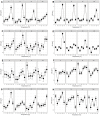Temperature Effects on Expression Levels of hsp Genes in Eggs and Second-Stage Juveniles of Meloidogyne hapla Chitwood, 1949
- PMID: 38732085
- PMCID: PMC11084963
- DOI: 10.3390/ijms25094867
Temperature Effects on Expression Levels of hsp Genes in Eggs and Second-Stage Juveniles of Meloidogyne hapla Chitwood, 1949
Abstract
Meloidogyne hapla is one of the most important nematode pathogens. It is a sedentary, biotrophic parasite of plants that overwinters in the soil or in diseased roots. The development of M. hapla is temperature dependent. Numerous studies have been performed on the effect of temperature on the development of M. hapla, but only a few of them analyzed the heat shock protein (hsp) genes. The aim of the study was to perform expression profiling of eight hsp genes (Mh-hsp90, Mh-hsp1, Mh-hsp4, Mh-hsp6, Mh-hsp60, Mh-dnj19, Mh-hsp43, and Mh-hsp12.2) at two development stages of M. hapla, i.e., in eggs and second-stage juveniles (J2). The eggs and J2 were incubated under cold stress (5 °C), heat stress (35 °C, 40 °C), and non-stress (10 °C, 20 °C, and 30 °C) conditions. Expression profiling was performed by qPCR. It was demonstrated that only two genes, Mh-hsp60 and Mh-dnj19, have been upregulated by heat and cold stress at both development stages. Heat stress upregulated the expression of more hsp genes than cold stress did. The level of upregulation of most hsp genes was more marked in J2 than in eggs. The obtained results suggest that the Mh-hsp90 and Mh-hsp1 genes can be used as bioindicators of environmental impacts on nematodes of the Meloidogyne genus.
Keywords: Meloidogyne hapla; bioindicator; expression; heat shock genes; incubation time; temperature.
Conflict of interest statement
The authors declare no conflicts of interest.
Figures



Similar articles
-
Effect of Vicia sativa L. on Motility, Mortality and Expression Levels of hsp Genes in J2 Stage of Meloidogyne hapla.J Nematol. 2023 Apr 14;55(1):20230009. doi: 10.2478/jofnem-2023-0009. eCollection 2023 Feb. J Nematol. 2023. PMID: 37082220 Free PMC article.
-
The cold tolerance of the northern root-knot nematode, Meloidogyne hapla.PLoS One. 2018 Jan 2;13(1):e0190531. doi: 10.1371/journal.pone.0190531. eCollection 2018. PLoS One. 2018. PMID: 29293608 Free PMC article.
-
Evaluation of suitable reference genes for gene expression analysis in the northern root-knot nematode, Meloidogyne hapla.PLoS One. 2019 Jun 19;14(6):e0218610. doi: 10.1371/journal.pone.0218610. eCollection 2019. PLoS One. 2019. PMID: 31216347 Free PMC article.
-
Characterization of the heat shock protein 90 gene in the plant parasitic nematode Meloidogyne artiellia and its expression as related to different developmental stages and temperature.Gene. 2009 Jul 1;440(1-2):16-22. doi: 10.1016/j.gene.2009.03.020. Epub 2009 Apr 5. Gene. 2009. PMID: 19348876
-
Developmental Dynamics of Meloidogyne hapla in Washington Wine Grapes.Plant Dis. 2019 May;103(5):966-971. doi: 10.1094/PDIS-07-18-1195-RE. Epub 2019 Mar 6. Plant Dis. 2019. PMID: 30840841
Cited by
-
Responses of root physiological characteristics and resistance gene expression to infection by Meloidogyne incognita at different temperatures in tobacco.Front Plant Sci. 2025 Jul 21;16:1592335. doi: 10.3389/fpls.2025.1592335. eCollection 2025. Front Plant Sci. 2025. PMID: 40761558 Free PMC article.
References
-
- Giné A., López-Gómez M., Vela M.D., Ornat C., Talavera M., Verdejo-Lucas S., Sorribas F.J. Thermal requirements and population dynamics of root-knot nematodes on cucumber and yield losses under protected cultivation. Plant Pathol. 2014;63:1446–1453. doi: 10.1111/ppa.12217. - DOI
MeSH terms
Substances
Grants and funding
LinkOut - more resources
Full Text Sources
Research Materials
Miscellaneous

